Table of Contents
Braised Squid is such a traditional and well-liked Shanghai style seafood dish. Known as Bi Mu Da Kao {比目大烤} in Chinese. We braise the whole squid in low heat first, let them cool down in the braising juice to soak up the flavor and then slice them into serving bite-size rings. The squid slices are so soft and super delicious.
Perfect to pair with rice, noodle or steamed buns {Mantou}. Perhaps the best way to enjoy an extremely yummy, nutritious squid cooked in an easy healthy way.
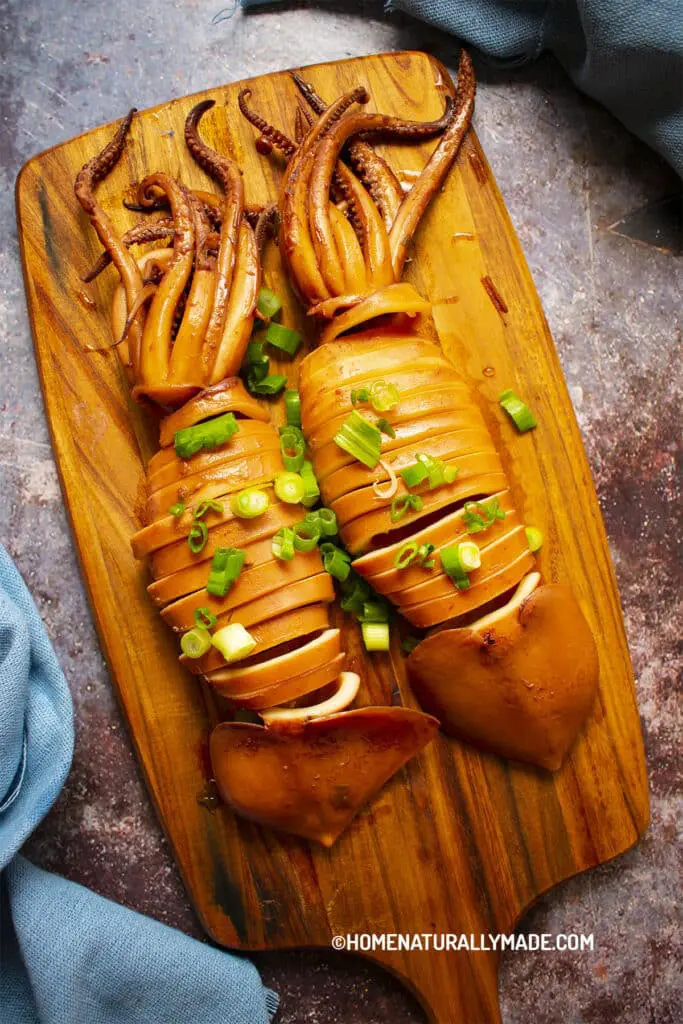
Shanghai style is an important integral part of Huai Yang Cuisine
Shanghai-style food is part of Huai Yang cuisine, one of the Four Great Traditional Chinese Cuisines. Huai Yang Cuisine {淮阳菜} is native to China’s Yangtze River Delta, a place I proudly call my hometown.
Well known for its natural deliciousness, Huai Yang Cooking Style aims to bring out the food itself’s inherent yumminess. This area is blessed with abundant seasonal fresh produce since ancient times. The simple condiments are only there to complement but not overshadow the food itself.
Huai Yang Style Food typically uses very little salt, and oil, and avoids any over-powering condiments, including hot peppers. Therefore, it is suitable for all ages, including young children.
It is worth mentioning that each major city in this area, take Shanghai, for example, over time has developed its own featured dishes.
Classic Shanghai Style food at-a-glance
Speaking of Shanghai Style cuisine, also known as Ben Bang Cai {本帮菜} in Chinese, Bi Mu Da Kao and Cong Kao Ji Yu {葱烤鲫鱼 Pan Fried Whole Crucian Carp with Scallions} are the two most important seafood dishes.
Other well-known Shanghai-style dishes include Red Braised Pork Chops {Hong Shao Da Pai 红烧大排}, Shanghai Soup Dumplings {Xiao Long Bao 小笼包}, Sheng Jian Mantou {Pan Fried Pork Buns 生煎馒头}, Sweet and Sour Ribs {Tang Cu Pai Gu 糖醋排骨}, and Stir Fried Rice Cake {Chao Nian Gao 炒年糕}.
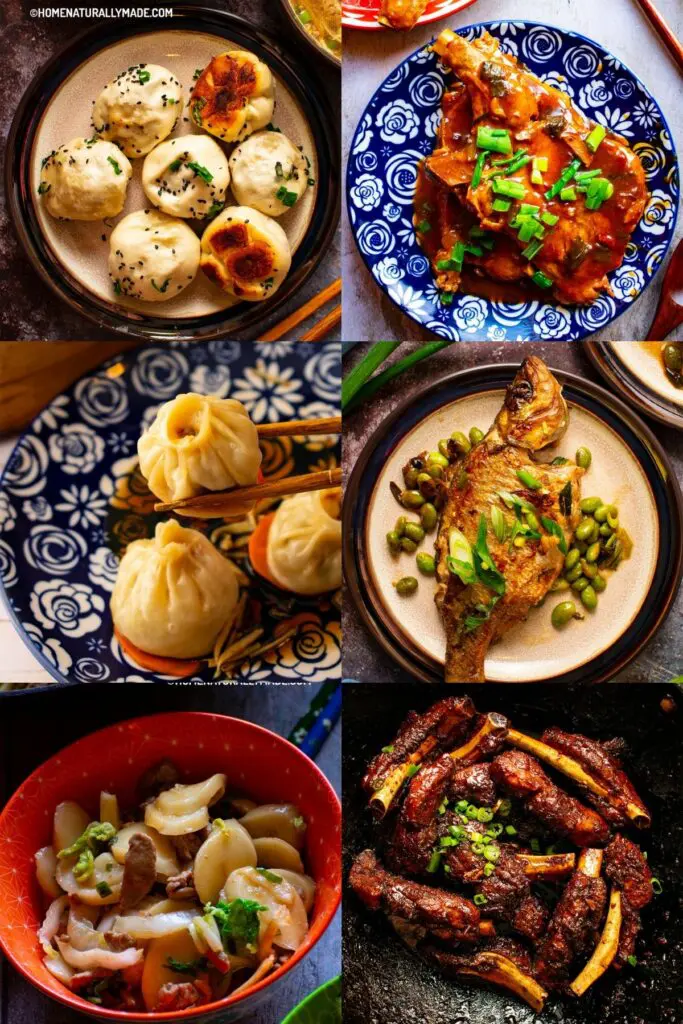
What do you need to make Braised Squid Shanghai Style?
For the squid, usually, you can get wildly caught frozen solid squid from Asian or International themed grocery stores.
Cleaning the whole squid could be an easy and efficient process as long as you know a few tips and tricks. Read here for a detailed step-by-step tutorial that shows you how.
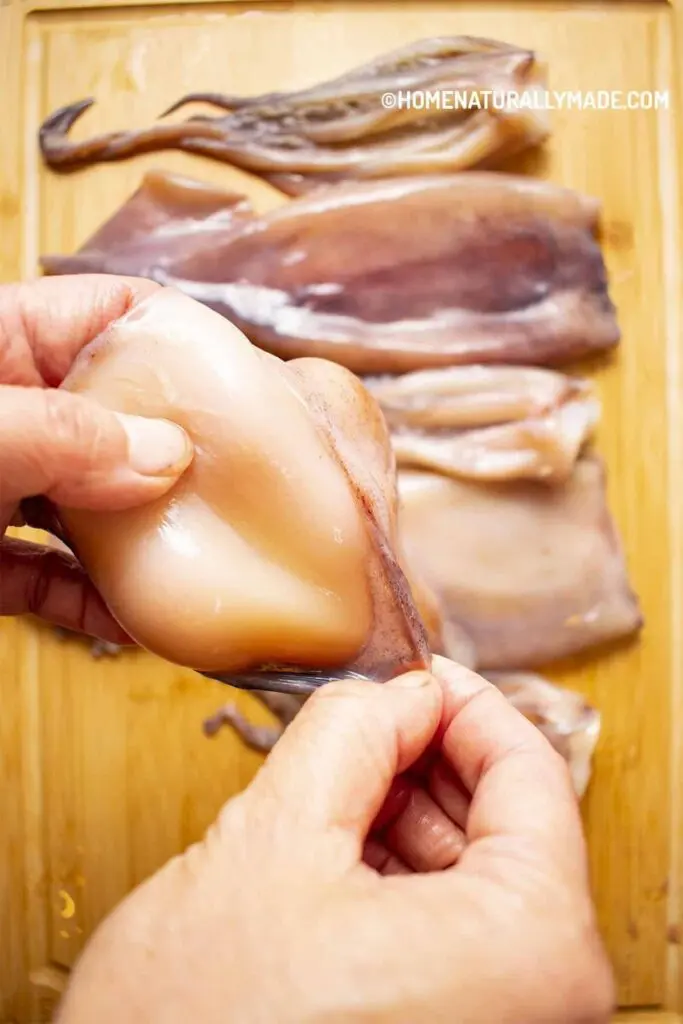
Other than the cleaned and peeled whole squid, you just need regular soy sauce, light soy sauce, star anises, bay leaves, and sugar as the key seasoning ingredients. Green onions and ginger are the fundamental herbs of Chinese cooking.
For sugar, I recommend either using “sugar in the raw” or unrefined rock sugar for the best results.
To highlight the flavor and color, you can either use rose tofu curd or a combination of traditionally fermented douchi and a hint of red yeast rice powder to highlight the flavor and color.
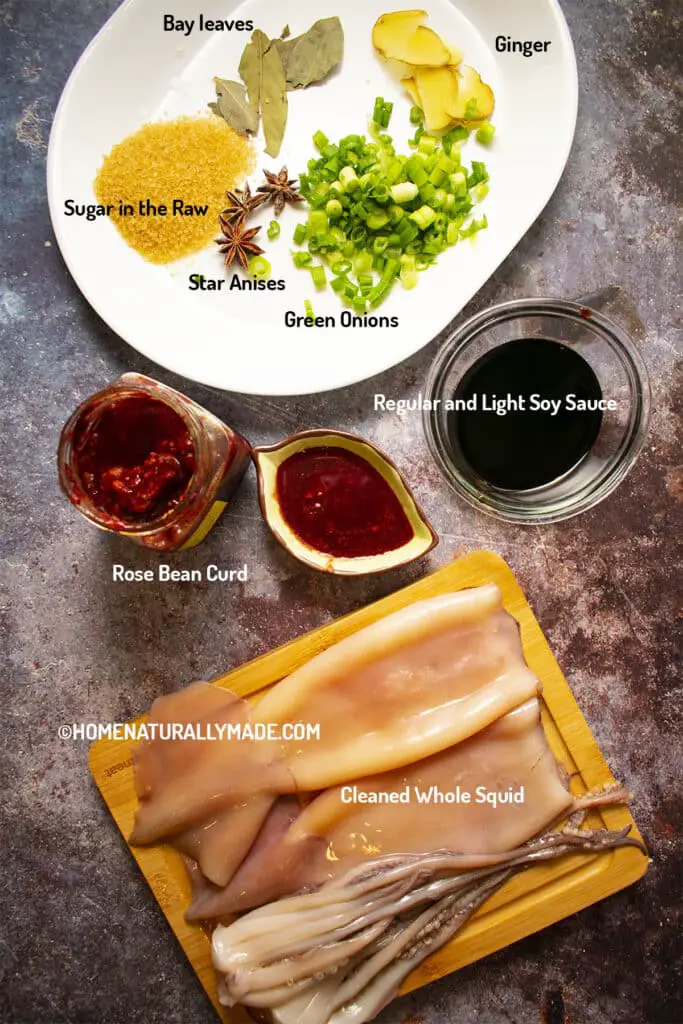
Rose Fermented Bean Curd {Fu Ru 腐乳} Fun Facts
What is Fermented Bean Curd?
Fermented bean curd, or Fu Ru {腐乳} in Chinese, is an ancient food with thousands of years of history. They are tofu products gone through multiple fermentation processes and steps and are then brined in rice wine, salt, and water.
Red vs. White Fermented Bean Curd
There are two major types of fermented bean curd, red vs. white. When red yeast rice is used during the fermentation process, the fermented bean curd turns into this beautiful red rose color. Otherwise, it is originally white/yellow color.
People often call the red version Mei Gui Fu Ru {玫瑰腐乳} or Rose Fermented Bean Curd.

Why is fermented bean curd {Fu Ru 腐乳} good for you?
Fermented bean curd is rich in protein since it is a soybean-based product. It also contains many essential vitamins such as B12 and minerals such as iron and calcium.
However, a word of caution, since it is usually extremely salty, a bit goes a long way.
We typically use fermented bean curd as a seasoning or condiment. When eaten directly, it is usually paired with unsalted porridge. Dip a tiny portion, which is already full of flavor by the way, and add to the spoonful of porridge.
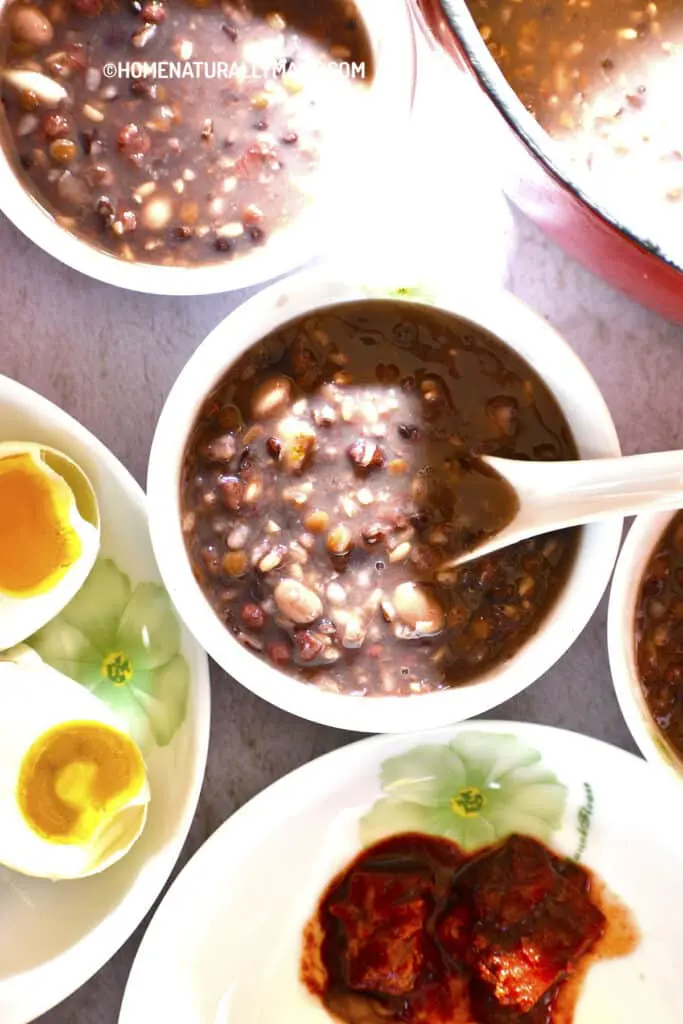
How to cook Shanghai Style Braised Squid perfectly each time?
The first is to sear the squid for braised squid
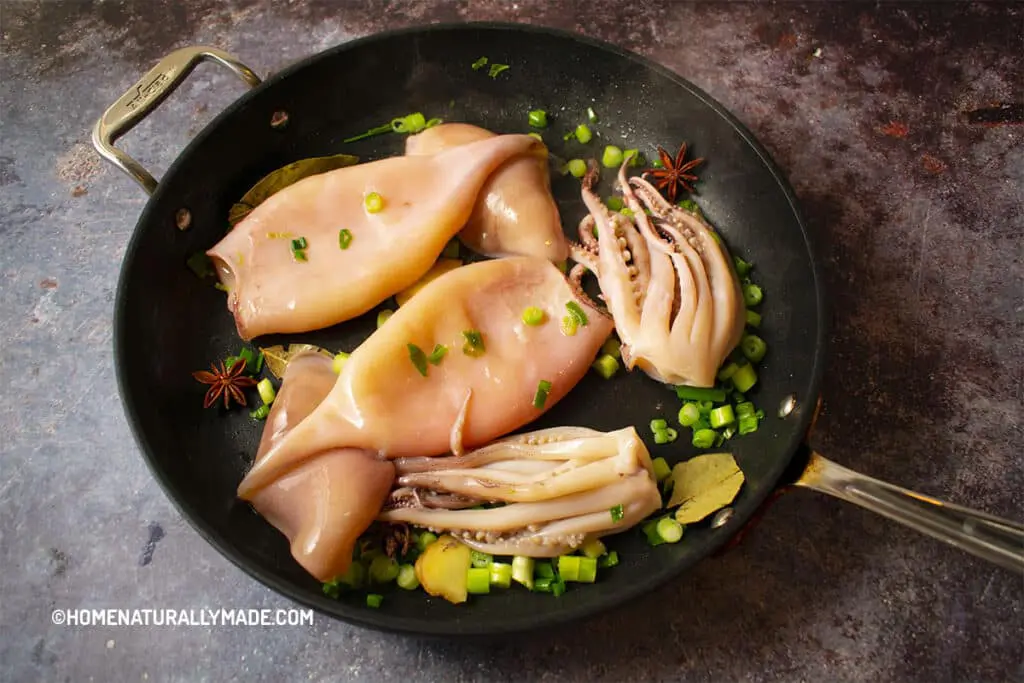
Heat the pan at medium-high for 2 minutes, then add oil and stir-fry spring onions, ginger, star anises, and bay leaves for about 30 seconds or till fragrant. Following that, add the whole squid along with the tentacles, and cook for 1 minute on each side.
The second is to braise the whole squid in low heat
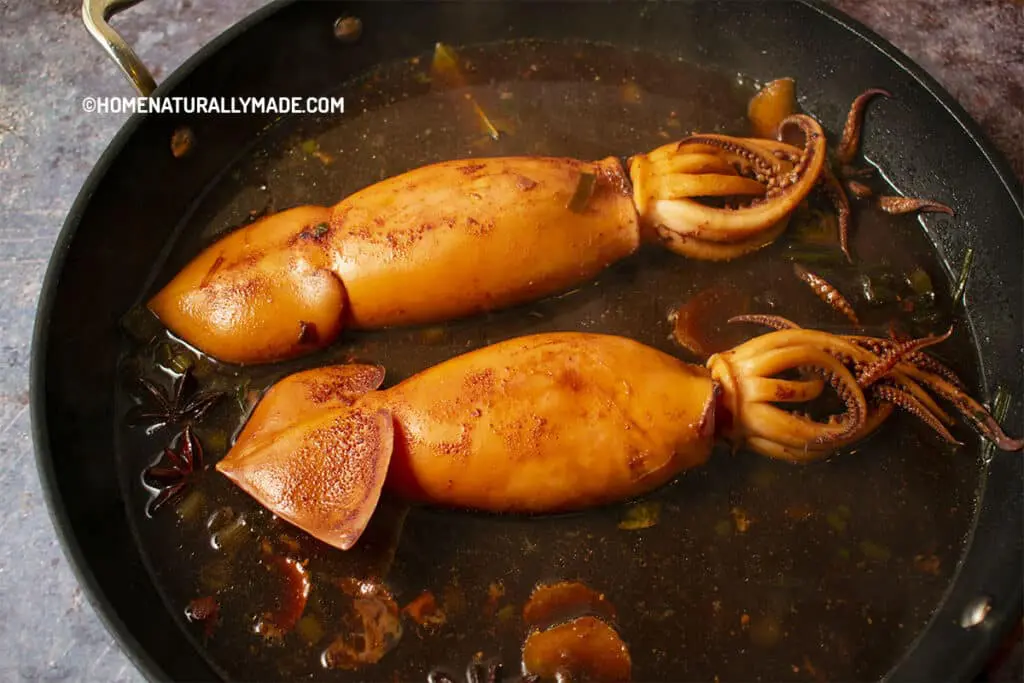
Pour the braising juice into the pan after you have properly seared the whole squid on both sides. Cover the pan with a lid and bring it to a boil. Once it is boiling, turn the heat to simmer and cook for 10 minutes. After that, turn the heat to low and cook for another 10 minutes. Mix, flip and baste the squid with the braising juice in between.
Cool the squid in the braising juice before slicing them
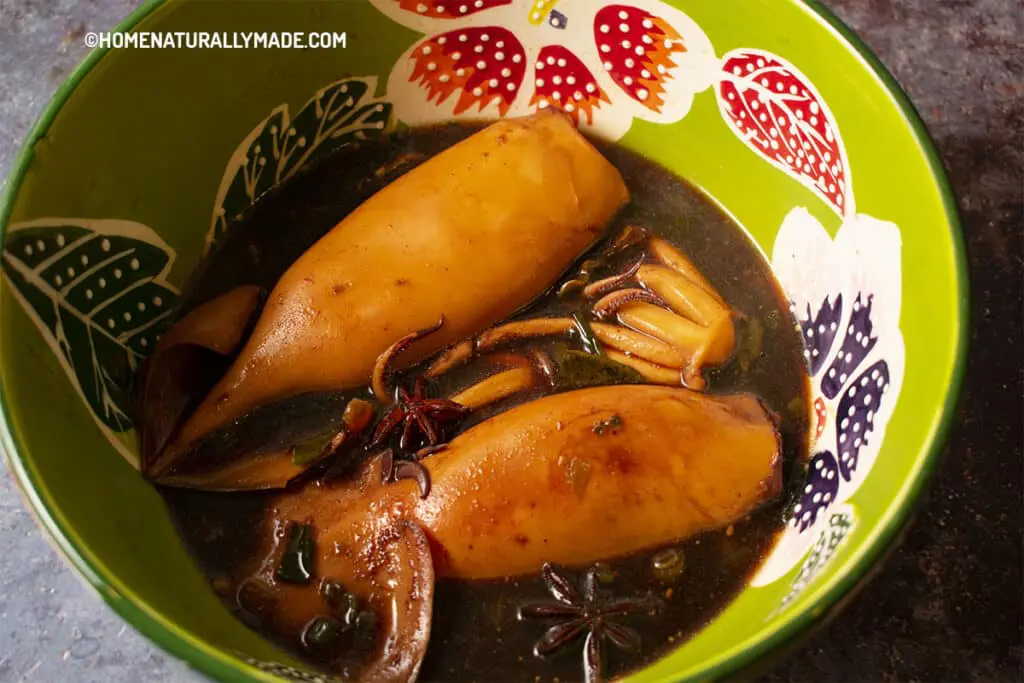
Make sure you do not over-cook the squid by either cooking in high heat or cooking for a prolonged time. Use a toothpick to test, if you can poke through the squid easily, they are done.
Remove the squid from the pan and place them into a large deep bowl along with all the braising juice and spices. Let them cool down to room temperature before slicing them and serving.
Re-arrange the squid body and tentacles and re-assemble them into a whole squid for a nicer presentation.

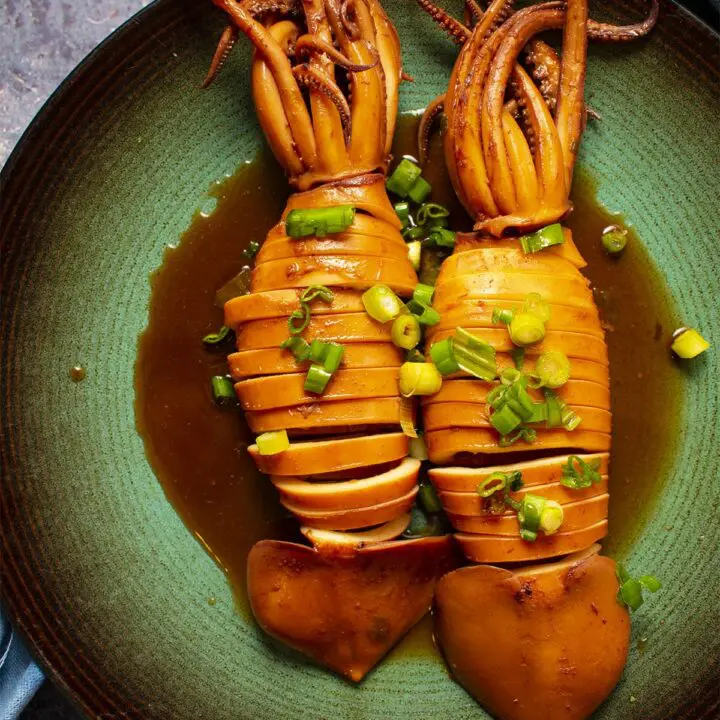
Braised Squid {Shanghai Style Bi Mu Da Kao}
Braised Squid is such a traditional and well-liked Shanghai style seafood dish. Known as Bi Mu Da Kao {比目大烤} in Chinese. We braise the whole squid in low heat first, let them cool down in the braising juice and then slice into serving bite-size rings. The squid slices are so soft and super flavorful.
Ingredients
- 2 whole squid, fully cleaned
- 1 tsp cooking oil such as avocado oil
- 10 slices of ginger
- 1 stalk of green onions, chopped
- 3 star anises
- 3 bay leaves
For Braising Juice:
- 4 tbsp light soy sauce
- 2 tbsp regular soy sauce, or dark soy sauce
- 2 tbsp sugar, such as sugar in the raw or organic unrefined cane sugar
- 1 tbsp original douchi, traditionally fermented, or use 1 small piece of rose tofu curd
- 1/4 tsp red yeast rice powder, as an all-natural red color, skip when using rose tofu curd
- 1 cup of water
Instructions
- Gather all the ingredients. Add everything under the "For Braising Juice" to a small bowl and set aside.

- Turn the heat to medium-high, and heat a 12-inch hard-anodized fry pan for 2 minutes.
- Spray about 1 tsp avocado oil, and use a mini silicone spatula to spread evenly. Add ginger, and about 80% of green onion, star anises, and bay leaves, and stir fry for about 30 seconds, or till fragrant. Leave some green onion for garnishing at the end.
- Add squid into the pan, and let them cook for 1 minute.
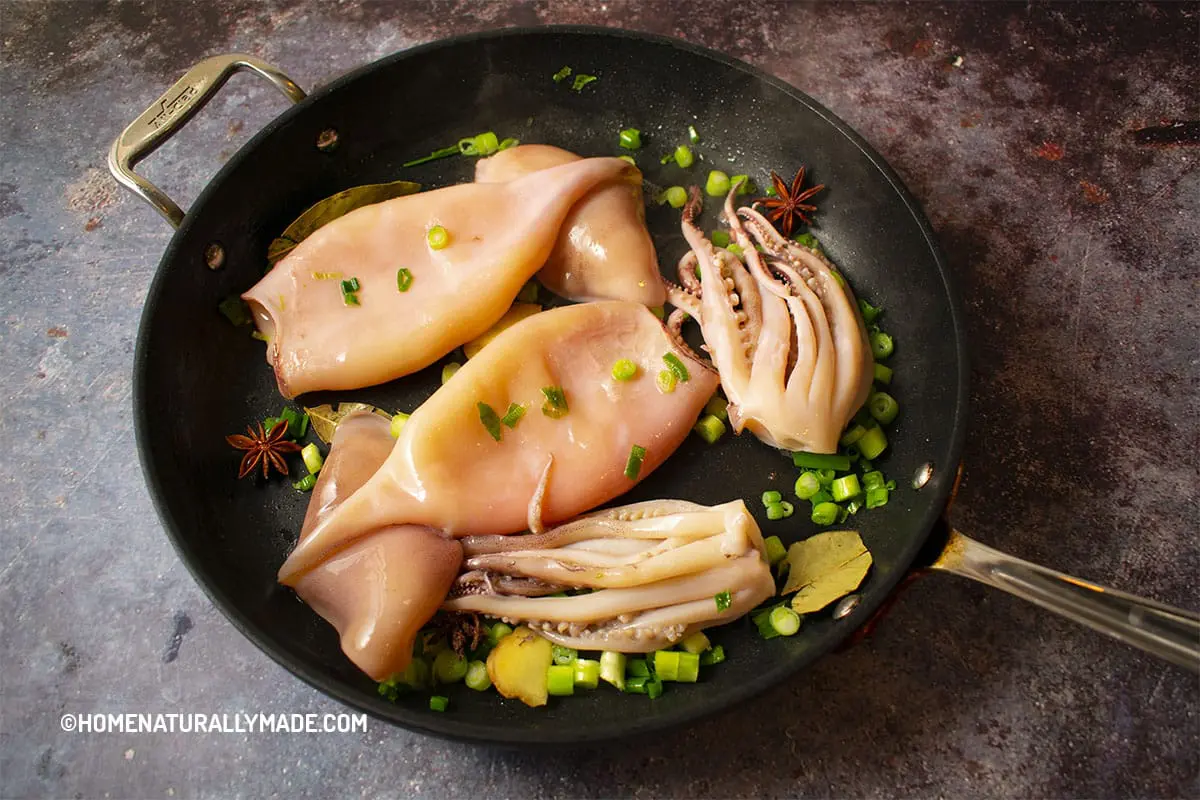
- Flip the squid and sear the other side for 1 minute too.
- Pour the braising juice into the pan. Fold and mix the juice with the squid. Cover the lid and bring it to a boil, about 2 minutes.
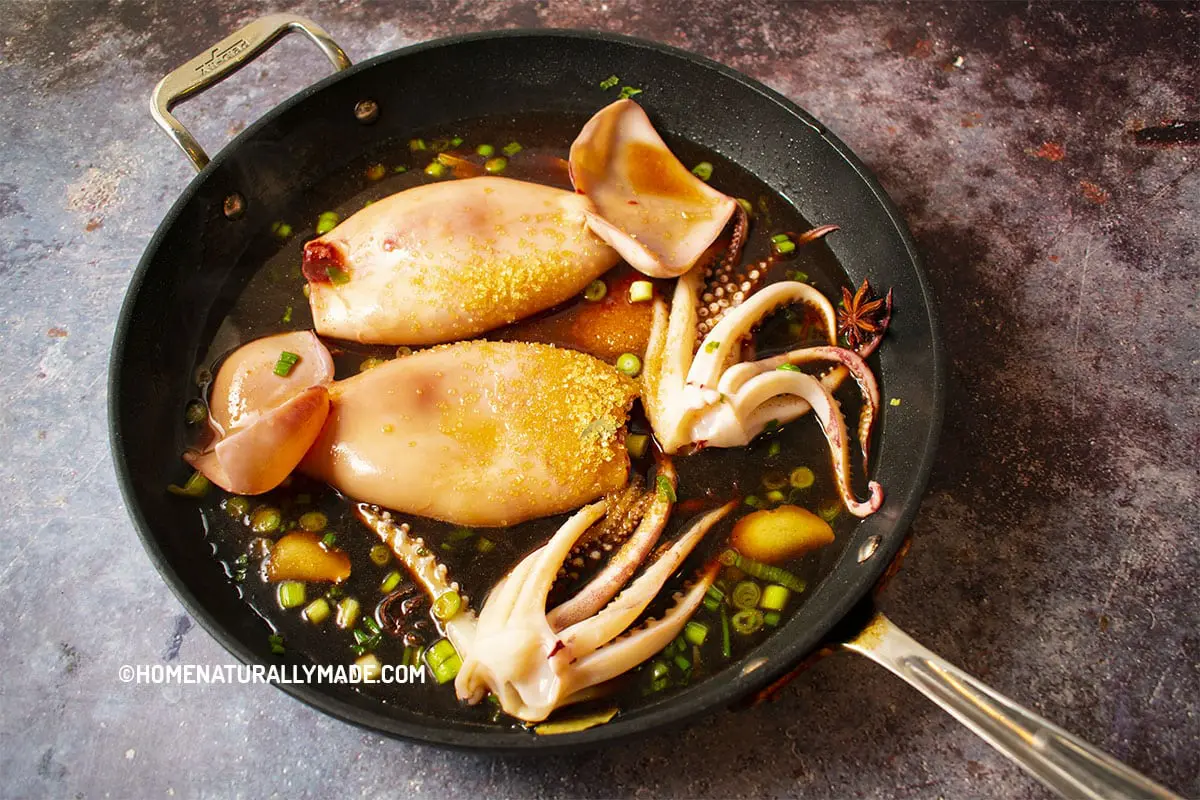
- Turn the heat to simmer, flip and baste the squid with the juice in the pan, cover the lid and cook for 10 minutes.
- Turn the heat to low, flip and baste the squid with the juice in the pan, cover the lid and cook for another 10 minutes.
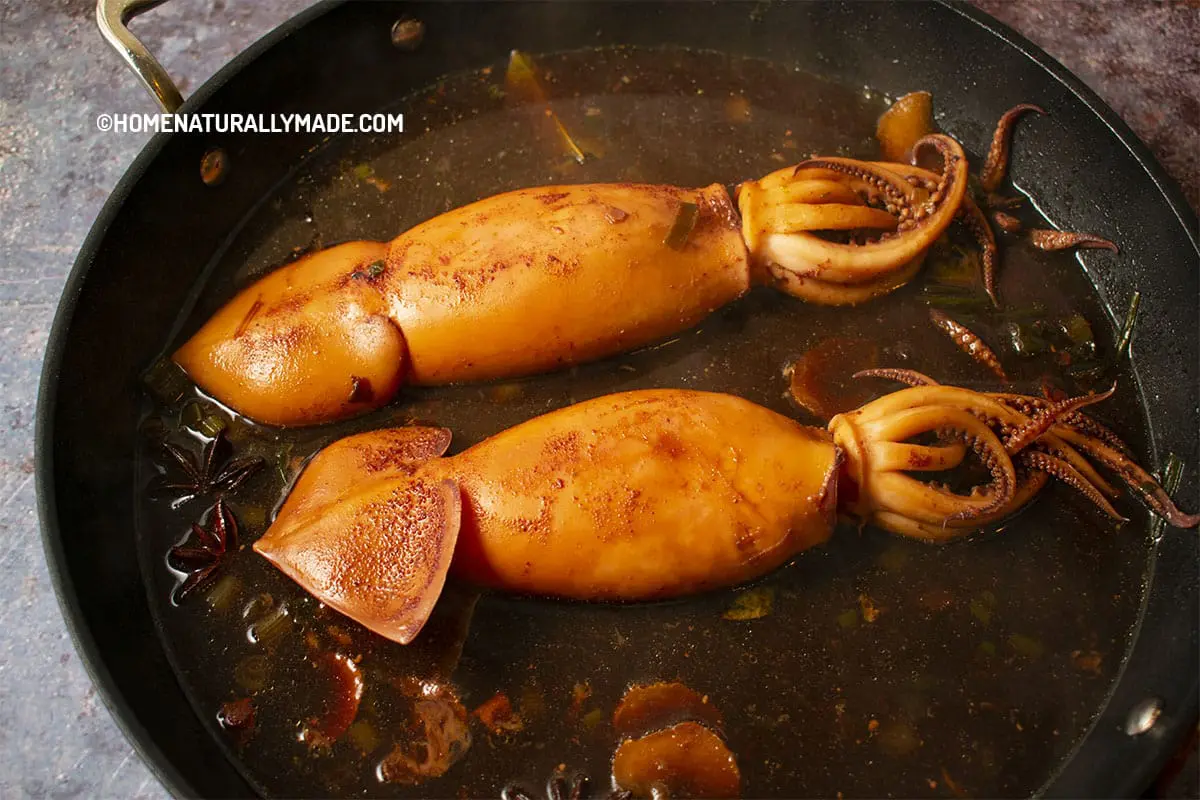
- Remove the squid from the pan and place into a large deep bowl along with all the braising juice and spices from the pan. Let it cool down at room temperature, about 20 minutes.
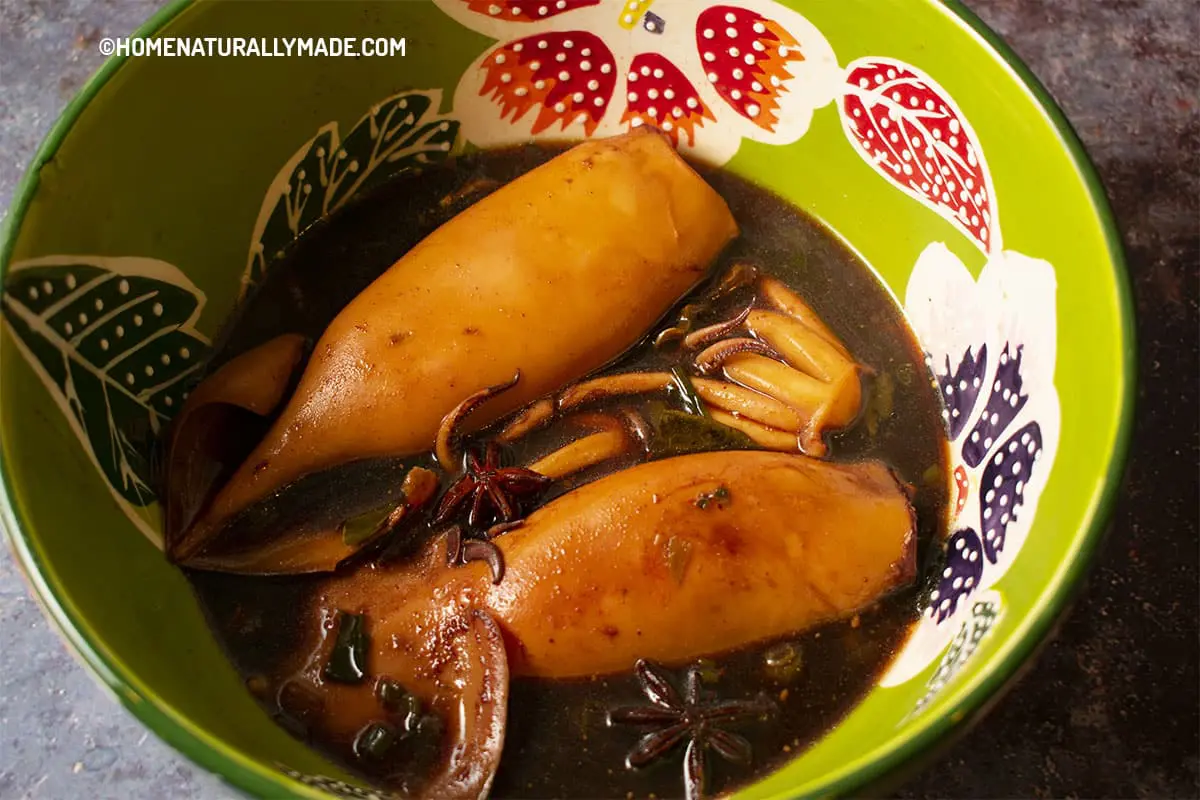
- Slide the squid across the body into thin bite-size rings. Slightly cut the tentacles along their natural connecting point. Re-arrange the squid body and tentacles and re-assembly into a whole squid for a nicer presentation. Garnish with the remaining green onions.
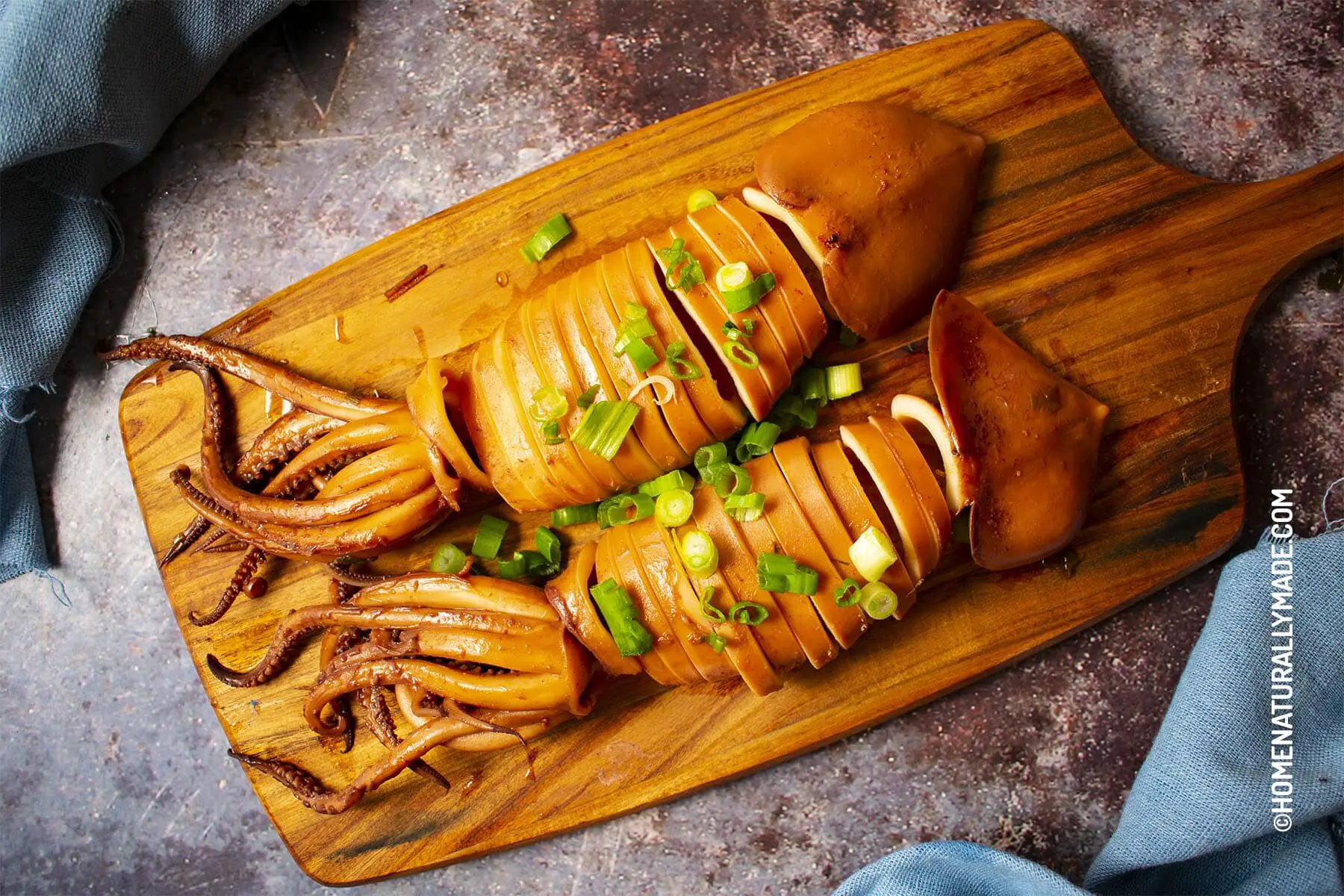
- All done! Enjoy a super delicious and soft squid.
Notes
- For douchi, there are many varieties on the market. Try to get the one that is traditionally and naturally fermented black beans without added preserves and chemical additives. The same applies to rose tofu curd. Try to get the traditional original one.
- Regular soy sauce, a.k.a Jiang You is naturally aged soy sauce, which is a traditional condiment used in China since ancient times. Light vs. dark soy sauce is modern time Cantonese invention. You can generally substitute regular soy sauce with dark soy sauce.
- For sugar, for best results, I recommend either using "sugar in the raw" or unrefined rock sugar.
Recommended Products
As an Amazon Associate, I earn a small amount of commission from the qualifying purchases.
-
 Coffee/Spice Grinder
Coffee/Spice Grinder -
 Red Yeast Rice 紅曲米
Red Yeast Rice 紅曲米 -
 Chinese Douchi
Chinese Douchi -
 Brown Rock Sugar
Brown Rock Sugar -
 Sugar in the Raw Unrefined Sugar - 32 oz - 2 pk, Set of 2
Sugar in the Raw Unrefined Sugar - 32 oz - 2 pk, Set of 2 -
 Star Anise Seeds
Star Anise Seeds -
 Bay Leaves
Bay Leaves -
 Wan Ja Shan Naturally Brewed Soy Sauce (2 Pack, Total of 33.8fl.oz)
Wan Ja Shan Naturally Brewed Soy Sauce (2 Pack, Total of 33.8fl.oz) -
 Light Soy Sauce
Light Soy Sauce -
 王致和 Wangzhihe Fermented Beancurd Tofu (Rose (Chunk), 3 Pack)
王致和 Wangzhihe Fermented Beancurd Tofu (Rose (Chunk), 3 Pack) -
 Amber Glass Oil Spray Bottle
Amber Glass Oil Spray Bottle -
 Small Silicone Spatulas
Small Silicone Spatulas -
 Hard Anodized Nonstick Fry Pan
Hard Anodized Nonstick Fry Pan -
 OXO Good Grips 3- Piece Mixing Bowl Set
OXO Good Grips 3- Piece Mixing Bowl Set
Nutrition Information
Yield 6 servings Serving Size 1Amount Per Serving Calories 134Total Fat 2gSaturated Fat 0gTrans Fat 0gUnsaturated Fat 1gCholesterol 22mgSodium 1260mgCarbohydrates 25gFiber 2gSugar 10gProtein 5g
Nutrition calculation is provided by Nutritionix to the best knowledge per ingredients description and isn't always accurate.
